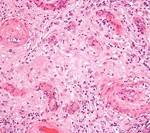Intrauterine Growth Retardation (IUGR)
What is IUGR ?
Intrauterine Growth Restriction Intrauterine growth restriction (IUGR) is a condition where a baby’s growth slows or ceases when in it is in the uterus. Twin pregnancies are twice as likely to be affected by IUGR, around 15% to 20% of twin pregnancies are found to have IUGR compared to 7% of single pregnancies.
How is IUGR diagnosed ?
A low birth weight is defined as a baby born with a weight that is inappropriately low for the duration of the pregnancy – for a baby born at term this would be a birth weight less than 2.5kg. The inappropriately low weight indicates that the growth of the baby in the womb has been unsatisfactory and this is why is is called Intrauterine Growth Retardation.
The majority of babies born small for their gestational age show catch-up growth over the first two or three years of life. However, in about a third complete catch-up growth does not occur. These children remain small and fail to reach their genetic potential as defined by their parental heights.
The diagnosis of IUGR is based on comparison of the babies weight centile at birth with standards which take into account he gestational age of the baby, ideally infant length should also be taken into account.
What are the causes of IUGR ?
There are many causes of IUGR and many cases are unexplained. The following is only a guide as to some of the causes :
- History of restricted foetal growth, hypertension, diabetes, raised alpha fetoprotein or hCG, chronic illness, low weight before pregnancy, poor maternal weight gain (<10kg by 40 weeks), twins, use of alcohol, tobacco or illicit drugs, maternal anaemia, vaginal bleeding, living above 3000 metres, severe lung disease.
- Infections – syphilis, CMV, toxoplasmosis, rubella, HBV, HSV, HIV
- Congenital disorders e.g. trisomy 21, 18, 13, Turner’s syndrome
- Placental pathology e.g. previa abruption
- Drugs – warfarin, phenytoin, steroids
- Maternal smoking causes 30-40% of cases of IUGR (11 cigarettes/day equates to babies weighing 330g less and being 1.2cm shorter on average than non smokers). IUGR occurs in 15-20% of cases of twins.
Abdominal circumference is correlated with baby’s weight; this information is important in deciding when to deliver the baby. If you have had lots of ultrasound scans that have shown a normal growth rate, even if the baby is small for dates this will most likely mean that your baby will simply be small and not growth restricted. Growth restricted babies will show a slowing down of growing over a matter of weeks.
Poor biophysical profile scores in a growth retarded foetus are an indication for early delivery. The time of delivery depends on how well your baby is doing. Sometimes, babies with IUGR keep on growing in the uterus. If your baby keeps gaining some weight, an early delivery (before the due date) may not be needed. But if your baby is not growing at all or has other problems, your doctor may decide that an early delivery could help. In this case, your doctor may want to induce labour.
Your baby’s heart rate and movements will be closely watched to help you and your doctor make this decision. If there are no signs of problems with your baby during labour, a vaginal delivery is OK. The length of your stay in hospital after the birth will depend on how early your baby was at birth, many babies born early will spend some time in hospital before they are allowed home. Generally, babies stay in the hospital until they weigh about 5 pounds and can breathe and feed normally. Most babies born with IUGR will gain weight and catch up with their peers at around age 2.
|
.
|
What are the causes of IUGR ?
There are various different causes :
Maternal causes :
Increasing maternal age Hypertension or heart disease Diabetes in pregnancy including gestational diabetes Maternal alcohol abuse causing fetal alcohol syndrome or fetal alcohol effects Maternal use of other drugs including cannabis Maternal smoking causes 30 to 40% of cases of IUGR Renal disease in pregnancy Thrombophilia Drugs including warfarin, phenytoin and steroids
Placental In many cases of IUGR the placenta is small and doesn’t
provide sufficient nutrition to the growing baby. In IUGR pregnancies blood flow
to the placenta decreases as pregnancy progresses, compared to normal pregnancy
when blood flow to the placenta increases throughout pregnancy to meet the growing
baby’s demand for oxygen and nutrition. Cell death (apoptosis); in pregnancies
complicated by IUGR, the placenta contains a relatively high proportion of cells
that have a shorter life than normal. This means the placenta functions less well,
thereby transferring fewer nutrients and less oxygen both to and from the baby.
Pre-eclampsia Fetal causes In multiple pregnancy one or more fetuses is often
small. Twins show IUGR in 15 to 20% of cases Chromosomal abnormalities including
Down’s syndrome, Edwards’ syndrome, Patau’s syndrome and Turner’s syndrome Congenital
defects are associated with Intrauterine infection such as cytomegalovirus, toxoplasmosis,
rubella and syphilis. with Intrauterine infection such as cytomegalovirus, toxoplasmosis,
rubella and syphilis. Risk Factors · History of restricted foetal growth, hypertension,
diabetes, raised alpha fetoprotein or hCG, chronic illness, low weight before
pregnancy, poor maternal weight gain (<10kg by 40 weeks), twins, use of alcohol,
tobacco or illicit drugs, maternal anaemia, vaginal bleeding, living above 3000
metres, severe lung disease. · Infections – syphilis, CMV, toxoplasmosis, rubella,
HBV, HSV, HIV · Congenital disorders e.g. trisomy 21, 18, 13, Turner’s syndrome
· Placental pathology e.g. previa abruption · Drugs – warfarin, phenytoin, steroids
Maternal smoking causes 30-40% of cases of IUGR (11 cigarettes/day equates to
babies weighing 330g less and being 1.2cm shorter on average than non smokers).
IUGR occurs in 15-20% of cases of twins

